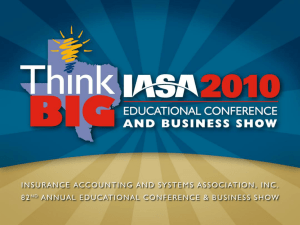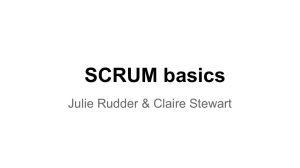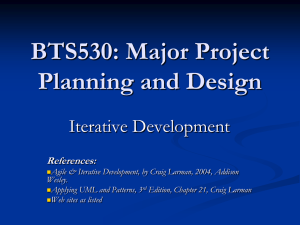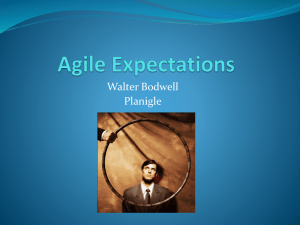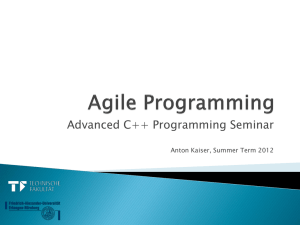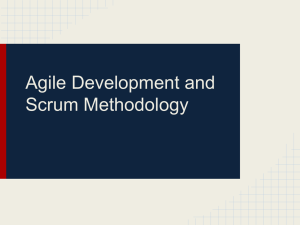SCRUM-based group work and assessment: a case study
advertisement
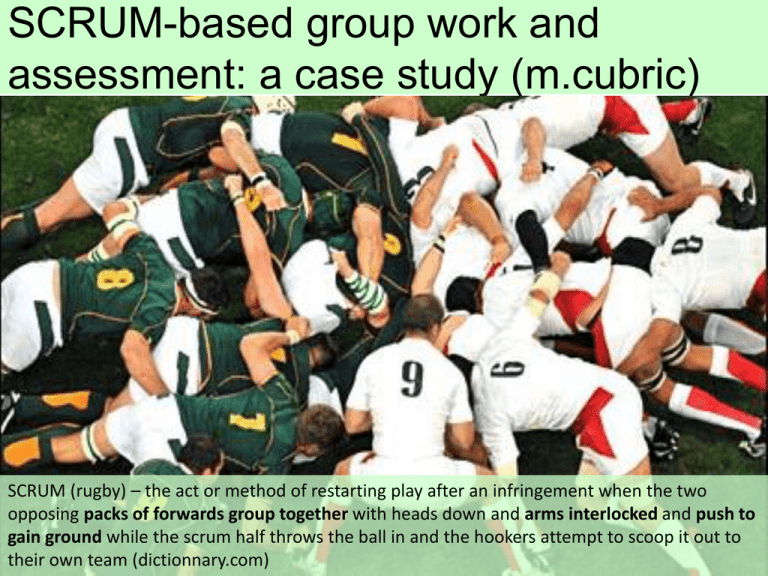
SCRUM-based group work and assessment: a case study (m.cubric) Marija Cubric, Business School/LTI, 05-05-11 SCRUM (rugby) – the act or method of restarting play after an infringement when the two opposing packs of forwards group together with heads down and arms interlocked and push to gain ground while the scrum half throws the ball in and the hookers attempt to scoop it out to their own team (dictionnary.com) Agenda SCRUM => Product Development => Learning and Teaching “The relay race approach to product development may conflict with the goals of maximum speed and flexibility. Instead a holistic or rugby approach where a team tries to go the distance as a unit, passing the ball back and forth may better serve today¹s competitive requirements.” Takeuchi and Nonaka (1986) + Case-study (groupwork assessment design & Students’ views) Takeuchi H. and Nonaka I. (1986) "The New New Product Development Game”, Harvard Business Review SCRUM – a Project Management Framework P R O C E S S & Iteration review Iteration retrospective Iteration planning Roles & Activities Product Owner Team Image adapted from: mountaingoatsoftware.com SCRUM Principles Cooperation amongst students Evidence of active Learning Student-staff contact Prompt feedback & responding to feedback Chickering & Gamson (1987) Chickering A., Gamson Z.F. (1987) Seven Principles For Good Practice In Undergraduate Education The American Association For Higher Education Bulletin Mapping SCRUM to L&T Context PM Roles, Artifacts and Activities Product Owner Team Scrum Master Product Backlog Sprint Potentially shippable product increment Daily SCRUM meetings Sprint Planning Sprint Review Sprint Retrospective SCRUM of SCRUMs Software release platform L&T Roles, Artifacts and Activities Mapping SCRUM to L&T Context PM Roles, Artifacts and Activities L&T Roles, Artifacts and Activities Product Owner Module Leader/Teacher Team Students’ group Scrum Master [Alternate role between team members] Product Backlog Coursework Sprint 1 or 2-weeks long coursework iteration Potentially shippable product increment Coursework in progress submitted for feedback Daily SCRUM meetings [10 minutes long group meeting] Sprint Planning Iteration planning meeting Sprint Review Iteration review meeting Sprint Retrospective Iteration reflection SCRUM of SCRUMs [Meeting between representatives of all groups] Software release platform Wiki SCRUM - a L&T Framework Weekly group meeting Coursework specification Final complete coursework submission Weekly assignments Weekly planning Teacher Weekly review & reflection Group Image adapted from: mountaingoatsoftware.com Case-study* Module: PG module on Agile Project Management** (“immersive learning”) Programs: MSc Project Management (Business School) , MSc in Business Computing (Computer Science) Number of students: 24 (split into 6 groups of 4) Sprint: 5*2 weeks long sprints Feedback: Studynet online form (after each sprint) Development platform: Wikispaces _________ * Method tailored through three consecutive academic years (started in 2007-8) ** Method is generic Project Specification Project Specification (group work) Sprint Planning Marking Rubric Group work (50%) Quality of articles owned by the group Quality of group process Individual reflective report** (50%) Factual knowledge Understanding Application Analysis Synthesis Factual knowledge Understanding Analysis Evidence of reading Presentation Use of internal links First group report* Second group report Third group report Fourth group report Fifth group report <0-5> Evaluation <0-5> Evidence of reading <0-5> Discussion <0-5> Presentation <0-5> Reflection <0-5> <0-5> <0-5> <0-5> <0-5> <0-5> <0-5> <0-5> <0-5> <0-5> <0-5> <0-5> <0-5> <0-5> <0-5> <0-5> Group Report (example) GROUP: School Of Thought NOTE: Input values are highlighted - everyting else are formulae that should not be changed TOTAL R11 table 1st iter. a. Number of new articles added to the “Agiloepedia” 2 85 b. Number of discussion posts c. Number of edits f. Agile principles and practices applied in the previous iteration g. Any problems preventing the group from delivering the work in the next iteration 4468 Min, max, mean and standard deviation (σ) values of group contribution of individual edits j. Number of internal links included (total/since the last iteration) 5th iter. 1 9 0 28 563 1027 886 1015 977 4% 8% and 5% 10% CAS; Cohesion 4% 4 23 6 See below See below None h. Turnitin similarity index for the articles owned by the group and attached turnitin report for all updated articles (new and existing) or as a minimum the URL of the turnitin report i. 4th iter. 2 16 See table below d. Sum of word counts of all articles owned by group e. (Numbered) list of recommendations from the feedback implemented in the iteration PER ITERATION 2nd iter. 3rd iter. 1 2 5 27 4% Pernding See table below Calculations for R11 member Member 1 Member 2 Member 3 Member 4 min max mean stdev stedv% 52 total number of edits 1st iter. 2nd iter. 176 158 127 83 50 33 7 26 83 176 136 35.26 6.48% 7 50 29 15.41 13.29% 6 13 EDITS PER ITERATION 3rd iter. 4th iter. 5th iter. 47 27 8 39 11 29 21 2 54 14 4 14 14 47 30.25 13.29 10.99% 2 27 11 9.82 22.33% 8 54 26.25 17.75 16.91% 44 46 43 25 25 46 39.5 8.44 5.34% Links to Theory … Learning by writing … Writing uniquely corresponds to some very powerful learning strategies such as: multi-representational and integrative re-enforcement, immediate self-provided feedback, establishment of systematic connections and relationships, analysis and Emig, J. (1977) Writing as a mode of learning. College synthesis (Emig, 1977) Learning by making … Composition and Communication, 28, 122-127. National Council of Teachers of English Effective learning happens in the context where “the learner is consciously engaged in constructing a public entity, whether it's a sand castle on the beach or a theory of the universe” (Pappert, 1991) Papert, S. (Ed.). (1991). Situating Constructionism. Norwood, NJ: Ablex Publishing Corporation Students engage in creating knowledge that can benefit others (students and teachers) (Holmes et al., 2001) Holmes, B.et al (2001). Communal constructivism: Students Learning by connecting … constructing learning for as well as with others. Technology And Teacher Education Annual, 3, 3114-3119 Learning occurs through pattern-recognition and connecting specialized Siemens G (2005) Connectivism: A Learning Theory For The information sets (Siemens, 2005) Digital Age. Elearnspace [Online] http://bit.ly/hiPhtk How students describe the method … Students value … tutor’s regular and prompt feedback … tutor’s interest and enthusiasm for the subject … links with practice and employability I started working the other day for Motorola and they are working using agile environments, agile methodologies. I don’t know anything about agile before I took the course but right now I am realising that we are using exactly the same things as Motorola. So it was really practical, … We got feedback after three …. A lecturer interested in a subject would have some current or four days from the time connection with it, it’s an energy that you can feel we submitted work and in I found that I had to other modules we submitted deliver something every coursework and its like three Sunday … And like you or four weeks or even more said the first couple of before we get feedback. And weeks it’s fairly intense sometimes when you get in terms of energy feedback, it’s not worth it levels, but you just because you don’t need it learn to get something anymore. out on the Sunday. student views Students’ learning was enhanced with constant review of the subject … early engagement with the module … tutor’s detailed feedback So in this way you have to perform some kind of work each week, you end up reviewing what you just learned. I think it’s the speed at which we had to engage … maybe in contrast to other modules where there wasn’t as participatory or as involved, with Agile, after a very short amount of time you are actually involved with doing things….. What are the main factors influencing group cohesion? Increased visibility of individual contributions? Explicit measurements of group cohesions (min, max, avg, stdev)? Cultural background (e.g. Hofstede, 2001) ? Feedback NOT ALWAYS used -feedback on iteration X used in iteration X+1, but improvements of iteration X sometimes delayed till the end Hofstede, G. (2001). Culture's Consequences: comparing values, behaviors, institutions, and organizations across nations (2nd ed.). Are findings from the business field applicable to L&T ? E.g. Whitworth&Biddle (2007)motivation and mohesion in agile teams influenced by: -Clear objectives, ease of interaction, frequent iterative delivery -“Agile planning was noted as especially valuable as a means of generating group agreement, and was seen to greatly reduce the tension and conflict” Whitworth E. and Biddle R. (2007) motivation and Cohesion in agile teams; Proceeding XP'07; Springer-Verlag Berlin, Heidelberg my observations How useful are group reports as evidence of group cohesion? -useful for managing expectations (e.g. TurnitIn similarity index useful) -Statistical measures could be tweaked, and too much time spent on making them look good – perhaps measurements should be done by the tutor? Evaluation 25 20 15 10 5 0 Agree Neither agree or disagree Disagree


